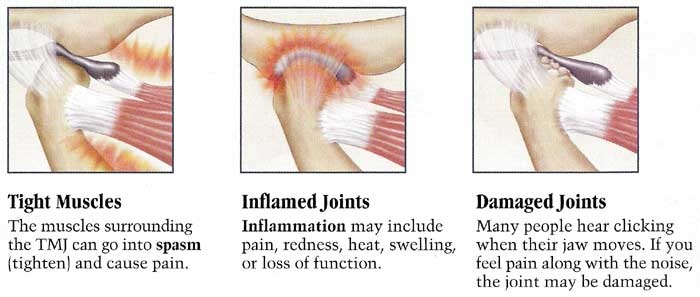TMJ disorders can be caused by many factors and can have a big impact on your quality of life. They can be caused by bite problems, injury, clenching and grinding, arthritis, or internal derangement. Symptoms include pain, headaches, dizziness, or a locked jaw and can persist for days to weeks to sometimes even years. Our dentists go beyond just bite guards and follow a treatment plan to address the root of your TMJ symptoms.
Symptoms include:
If you or your dentist suspect you might have a TMD, your dentist will use several techniques to diagnose your problem.
During your diagnosis or consultation, we will talk to you about your symptoms and history and inspect your jaw joints, tissues, and how your teeth bite together. If your symptoms are due to TMJ, we will then pursue a treatment plan that is custom made for you. We believe when treating TMJ a conservative and minimally invasive approach is best.
Many cases will involve making a bite guard for you to help alleviate stress on your joints, muscles, and tendons. The bite guard fits over your upper or lower teeth to lessen the effects of clenching or grinding, reduce the load on your jaw joint, and even out the way your teeth bite together. Most patients only need the biteguard and may use it all the time or intermittently when symptoms arise.
If further treatment is needed, there are three main approaches that we can use separately or together:
Eating soft food such as yogurt, mashed potatoes, soup, scrambled eggs, fish, and cooked fruits and veggies will help to reduce your symptoms. Extreme jaw movements and harder to chew foods such as chips, raw veggies and most candy may trigger symptoms. Caffeine may also exacerbate problems because it can cause us to clench and grind our teeth.
Over-the-counter anti-inflammatory medications such as ibuprofen (Advil) can help by reducing pain or swelling. Your dentist may also prescribe stronger medications for you if needed. You may apply moist heat to the side of your face and temple area for 10 minutes 2-3 times a day or more frequently if needed. See additional care information.
Physical therapy may also help in some cases. We may recommend a consultation with a specialist for internal joint derangements, trauma, or arthritis.



